
Grevillea excelsior, commonly known as flame grevillea or yellow flame grevillea, is a species of flowering plant in the family Proteaceae and is endemic to the south-west of Western Australia. It is an erect shrub or small tree with usually divided leaves with linear lobes, and clusters of orange flowers.
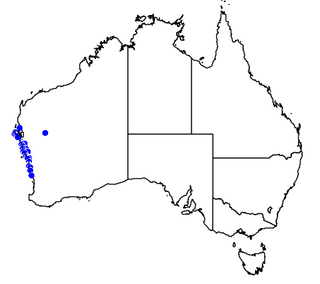
Commersonia borealis is a species of flowering plant in the family Malvaceae and is endemic to the southwest of Western Australia. It is a low growing, spreading shrub with egg-shaped to oblong leaves, and white, yellow and cream-coloured flowers.

Isopogon alcicornis, commonly known as the elkhorn coneflower, is a plant in the family Proteaceae and is endemic to part of the South Coast Western Australia. It is a low shrub with pinnately-lobed leaves and oval heads of hairy, white or pink flowers.
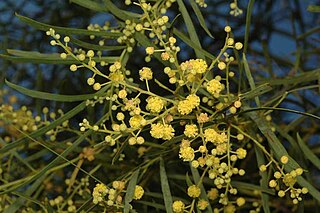
Acacia aestivalis is a species of flowering plant in the family Fabaceae and is endemic to the south-west of Western Australia. It is a bushy shrub or tree with linear to narrowly lance-shaped phyllodes, the narrower end towards the base, racemes of 5 to 11 spherical heads of golden-yellow flowers, and glabrous, papery to thinly leathery pods.
Verticordia muelleriana is a flowering plant in the myrtle family, Myrtaceae and is endemic to the south-west of Western Australia. It is an openly branched shrub with relatively large, egg-shaped to circular leaves and long spikes of deep maroon coloured flowers in spring and early summer.

Grevillea incrassata is a species of flowering plant in the family Proteaceae and is endemic to inland south-western Western Australia. It is an erect shrub with crowded cylindrical or narrowly linear leaves and clusters of bright yellow flowers.
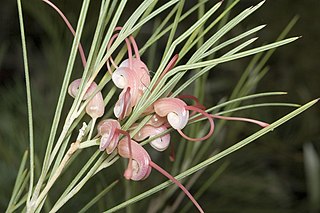
Grevillea oncogyne is a species of flowering plant in the family Proteaceae and is endemic to inland areas of Western Australia. It is an erect to spreading shrub with linear, sometimes lobed leaves, and clusters of red or pinkish red flowers.

Kunzea montana, commonly known as mountain kunzea, is a flowering plant in the myrtle family, Myrtaceae and is endemic to the south-west of Western Australia. It is a shrub or small tree with more or less round leaves and heads of cream-coloured to pale yellow flowers on the ends of the branches in late spring. It is an uncommon species, growing on rocky mountain slopes, but all populations are conserved in the Stirling Range National Park.
Styphelia tamminensis is a species of flowering plant in the heath family Ericaceae and is endemic to the southwest of Western Australia. It is a slender shrub with many branches, overlapping triangular to egg-shaped leaves and white, tube-shaped flower arranged singly in upper leaf axils.

Androcalva luteiflora is a species of flowering plant in the family Malvaceae and is endemic to western Australia. It is an erect, sucker-forming shrub with egg-shaped leaves, the edges irregularly toothed, and clusters of 3 to 18 or more yellow flowers.
Goodenia eremophila is a species of flowering plant in the family Goodeniaceae and is endemic to inland areas of Western Australia. It is an ascending herb with linear to elliptic leaves and thyrses of blue flowers.
Goodenia nuda is a species of flowering plant in the family Goodeniaceae and is endemic to the Pilbara region of Western Australia. It is an erect to ascending herb with elliptic to lance-shaped leaves at the base of the plant, and racemes of yellow flowers.
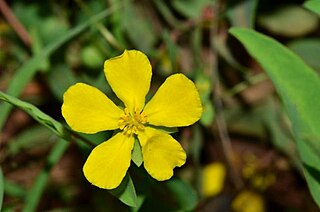
Hibbertia silvestris is a species of flowering plant in the family Dilleniaceae and is endemic to the south-west of Western Australia. It is a prostrate to more or less erect or spreading shrub with hairy young branchlets, elliptic to egg-shaped leaves with the narrower end towards the base and yellow flowers with seven to ten stamens on one side of two softly-hairy carpels.
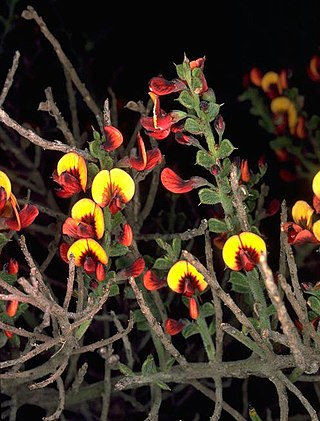
Daviesia dielsii, commonly known as Diels' daviesia, is a species of flowering plant in the family Fabaceae and is endemic to the south-west of Western Australia. It is on intricately-branched shrub with sharply-pointed, egg-shaped, vertically compressed phyllodes, and yellow and red flowers.
Lasiopetalum dielsii, is a species of flowering plant in the family Malvaceae and is endemic to the south-west of Western Australia. It is a spreading shrub with hairy stems, heart-shaped leaves and pink or white flowers.
Grevillea ceratocarpa is a species of flowering plant in the family Proteaceae and is endemic to inland areas of the south-west of Western Australia. It is an erect or spreading shrub with softly-hairy, narrowly elliptic or narrowly egg-shaped leaves with the narrower end towards the base, and creamy-white flowers.
Lasiopetalum microcardium is a species of flowering plant in the family Malvaceae and is endemic to the south-west of Western Australia. It is a low, spreading or straggling shrub with hairy stems, heart-shaped leaves and blue, purple or white flowers.
Pimelea gilgiana is a species of flowering plant in the family Thymelaeaceae and is endemic to near-coastal areas of north-western Western Australia. It is a shrub with narrowly egg-shaped leaves and head-like clusters of white or pinkish, dioecious flowers.
Thomasia multiflora is a species of flowering plant in the family Malvaceae and is endemic to the south-west of Western Australia. It is a low, spreading shrub with broadly egg-shaped leaves and mauve flowers.

Swainsona tenuis is a species of flowering plant in the family Fabaceae and is endemic to western continental Australia. It is a prostrate perennial herb with many stems, imparipinnate leaves with 5 to 9 egg-shaped leaflets with the narrower end towards the base, to linear or elliptic leaflets, and racemes of up to 7 purple flowers.










